Madan Lal Gupta – Innovations in Bricks/Archana H Colquhoun
This is an extract from a long series of exchanges via email and WhatsApp with the sculptor, Madan Lal Gupta, which started in November 2017 (with me living in the U.K. and the artist in Varanasi, India). The exchanges are largely in the form of an interview, with me posing questions to the artist. However, within the framework of an interview I included various constructs for a study of the artist’s work. I interspersed my queries with narrations of my own experiences drawn from my practices as an art critic and a visual artist. The exchange(s) will be referred to at various points as “the Project.”
- The Methodology of the Project
In the exchanges with Madan Lal, I employed a method of inquiry, which free-wheeled between art historical methodologies such as formalism, iconography, semiotics, biographical study, psychoanalysis, and social and critical theories, among others; the interchange between methods happened spontaneously as the project grew.
The project with Madan Lal gave me the opportunity to experiment with the uses and applications of various art methodologies. I would like to use a term “integrated methodology” to describe the mixed approach I used in putting together this project. When I started working on the project with the artist, I already had my bag of tricks ready. The stratagems grew and multiplied as the project developed.
Due to the passion and involvement that Madan Lal brought to this project, providing me with (unwavering commitment) all of the visual and written material I requested of him, at various stages, the exchanges took on a form so expansive that they turned into a major project.
- Without an artist cooperating and participating in a synergistic working with a critic on the study of their work, a project such as the present one would not come to fruition. The project by no means is complete and the exchanges can be presented in a number of different formats.
My ideas for an integrated methodology for the study of visual art came about as a direct result of me setting aside the practice of art criticism to reinvent myself as a visual artist in the late 1980s and 1990s, after I moved to Tokyo.
Aspects of the integrated methodology that I employed in this project can be seen in the extracts below on Madan Lal’s brick works. Simply put the methodology has a non-linear, inquiry-based approach into which is woven an analytical working of the study of an artist’s work taking the artist’s own articulations of their thought processes, out of which their artworks materialize.
A multidirectional investigation, deconstruction and reconstruction, associative thinking, and a seamless reversal of roles between the artist and the critic are the chief characteristics of the integrated methodology I developed while working on the project.
Through this method of inquiry a meeting, merging, and shifting of roles of the artist and the theoretician takes place. By involving the artist in an exchange that is unpredictable and which changes course unexpectedly, the artist is provoked into reassessing their work and looking back at the artistic choices they made.
By participating in such an exchange, the artist can engage in modes of self-inquiry, which the artist perhaps had not even considered possible or at the very least may have dismissed such self-reflections as being unnecessary to the development of their art practice.
- In my experience, however, the artist would ultimately find such interactions with a critic to be an enriching experience. [Refer to the section “Artist’s Feedback” provided at the end of the write up.]
THE EXCHANGES
- Archana, Mon, 18 Dec, 2017 (one of the questions from earlier on in the project)
You have worked with various materials: brick, stone/marble, iron (steel), bronze, clay and others perhaps. To my question as to which of these materials are your preferred materials and the reasons for the preference you had responded by saying you give equal importance to all of these materials, except perhaps marble since you have worked extensively in marble.
- Madan Lal responds
*(Below is a Google translation of the artist’s original text in Hindi with minor amendments made by me for clarity of expression.)
“Art is life that takes the form of an art work which is articulated through various materials. The material is a body into which life enters as a soul and this is not the importance of the material itself, but how the soul resides within that material, the whole meaning of a work connects to that soul. The quality of the material can be soft like soil, smooth like marble, rough and abrasive like stone, cold and hot like iron, shiny like brass, and runny like water. There are different kinds of materials. The artist gives birth to his art in these materials from time to time according to the needs of his artistic expression. That is why I believe that material is just a material for me, but its inherent qualities energize my art, give it longevity, make it eternal, which lives continuously over time.” Madan Lal
[Note on the flow of exchanges with reference to the above: Madan Lal’s answers are at times tangential , perhaps due to their spontaneous and heart-felt nature. The artist, however, contributes positively to the discussion and his answers shed light on his relationship with the materials he uses and the forms he creates. ]
- Archana on Madan Lal’s use of bricks as an art material
I would like to take up your brick works for discussion. I am especially curious as to what sort of forms you are able to create using bricks. Bricks have their limitation in terms of form and size and they are man-made products used almost entirely in the construction industry.
The texture and the brittle nature of the composition of bricks and the material used to create them, followed by the baking process, seems to be totally at variance with the forms you create from marble, which are sensuous, smooth, clean, and free-flowing.
Brick as a material is both hard and fragile, crumbling and disintegrating when pressure is applied, and poses special challenges for an artist.
When and how did you come upon the idea of using bricks in your work? And could you take me through your journey of brick works?
Also, I’d like to see images of your brick works with the dates, dimensions of the works, and places where you made them.
Disclaimer: In the excerpts, some of Madan Lal’s responses are in Hindi, which have been translated into English. His responses in English have been edited to make the text homogeneous in expression.
- Madan Lal responds with a poetic description of the qualities of bricks, which is followed by a chronology of his brick works, with narrations by the artist on the processes and concepts of his works from each period. Quoted below is the artist’s original statement in Hindi.
“Eent ke murtishilp mein vyaapt vishamta, khurdurapan, saadgi, arthavyavastha, tapasya, vinamrata, antarangata, prakrutik vastuon aur prkriyaon ki sundarata shamil hai aur yehi sabhi soundarya ke gun hai” Madan Lal
*Note: Below is a google translation of the above statement in Hindi by the artist on bricks, which will be referred to at various places below in the context of discussing specific works.
“A brick sculpture has coarseness, simplicity, economy, austerity, humility, intimacy – encompassing the beauty of natural objects and processes, which are the attributes of all beauty” Madan Lal
- Chronology of the Brick Works 1979 to 2021
Artist’s Narration on his first brick works – 1979 Baroda (parts of the text not in inverted commas are edited versions of the artist’s statements)
I worked with bricks for the first time when I came to Baroda in 1978 after graduating from Banaras Hindu University. I had to start a new life in Baroda due to the “death of my beloved guru Ram Chhatpar.”
“I was worried how I could live and work in a city like Baroda.” “I had to prepare/ create new sculptures for my one man show in New Delhi in the coming month of April 1979”
“My financial condition was very bad.”
“Just before coming (to) Baroda, I had an interesting experience which changed my “thought” regarding the choice of material. In Banaras, one day I was going with some of my senior friends to the fine arts faculty’s canteen. On the way, I saw a lot of bricks lying on the roadside and I asked Sumita Chakrawarty…” ” Didi, can I do sculptures in bricks?” She answered, “Yes, why not?” The reply was (God-gifted).
In January 1979, I joined the department of Sculpture at the Faculty of Fine Arts, Baroda as a non-collegiate student.
“I was in a great hurry to begin my new works due to the show. Within a week I had collected many “sized – unsized” bricks from the pathway from the faculty premises.” “So many raw, some of them unshaped and different”…. “After the collection, I requested Krishna Chhatpar Sir for carving tools etc;”
“A new question arose as to what to carve in bricks? I had not much time to wait for ideas or inspiration – then I looked at my last works (bronzes) where I had made ‘Reclining Figures’”… “and I created (a) sculpture in brick ”.. “a reclining figure of a woman, very simple, suggestive and impressive. ”
“What will be (the) second, third, and more? Then I arranged (a) few in groups of 2, 3, and 4, 5 or more – vertical, horizontal, standing and lying on the ground.” “At the same time, I got many kinds of very simple shape(s) like figure(s), leaf, bud, flower almost very abstract.” “Finally, in 2-3 months I made 9 sculptures in brick. The experience was a wonder for me and I realized that art is only in you not any other place. ”
“The first experience in Baroda with students and with teachers too, were not much pleasant, maybe I guessed that I was not able to interact and impress them intellectually. ”
“In this regard, I hesitate (d) to (approach) and show my works to them. Anyhow everywhere some fortunate (event happens) in your life,” “I found encouragement” from Nasreen Mohamedi “always during my stay in Baroda.”
Few Images of brick works made in Baroda 1979

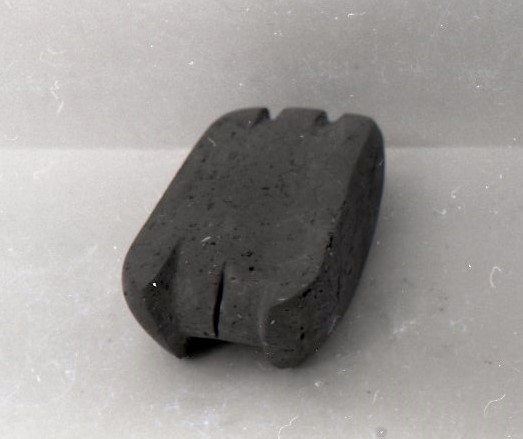
- Critical Appraisal of the Baroda works – Archana
Madan Lal’s first attempts at using bricks to make sculptures cannot be considered as particularly innovative in their form and artistic expression. However, the artistic value of a work need not be judged based on the level of creativity or artistic skill but on factors such as “problem solving” and in the timely production of artworks within the deadline of a project.
Also, Madan Lal was able to find a solution to his lack of financial resources to create works for an impending exhibition by picking up a material that cost nothing and which was readily available on the roadside.
Another point that the artist made elsewhere in the exchanges was that these brick works solved the problem of costs further by him doing away with the use of pedestals to display the works in the exhibition.
These first bricks works of Madan Lal’s can be best described using the term “Vishamta,” taken from the artist’s own description of the qualities of bricks. The synonyms of the word are: irregular, coarse, asymmetrical, a separation or gap, a contrast between things etc. The last few synonyms “gap, separation, contrast” can be understood to mean a gap between what is expected of the artwork and what is actually delivered.
It could also refer to the artist’s feeling of a disconnect with Baroda, which he saw as an elite institution. This was in the early days of his Baroda experience.
Madan Lal, uses another term “khurdurapan” which aptly describes the rough and unpolished quality of his first brick works made from bricks manufactured in India for building purposes.
There is one other aspect to how the artist approaches his art practice. He uses the term “God-Gifted.” The belief in providence/divine intervention is something that most contemporary artists – who have found professional success that is out of the ordinary – almost never refer to.
- Madan Lal responds
Artist’s Narration – 1987 Tokyo
The next time I did Brick sculptures was in Tokyo at Tama Art University. I think you had seen the show at Setagaya Art Museum in Tokyo in 1987 with Rajeev Lochan’s paintings. The response to these works gave me recognition as an artist in Japan, and I received many offers for shows from Japanese galleries. I was awarded the Semi Grand Prize for the works. This sort of recognition took me to new heights in my artistic pursuits. I carved 225 bricks in 2 months and made 5 sculptural compositions. I worked around 8-10 hours every day. I consider these works to be original in design; the chosen forms are unique but rooted in our native Indian tradition.
These works started off as experiments using bricks but soon developed into planned, organized works that are complex in design and concept.

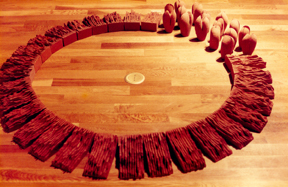
- Critical Appraisal of the Tokyo works – Archana
Madan Lal’s next set of brick works done in Tokyo in 1987 are a contrast to his first set of brick works made in Baroda. It is these works made in Tokyo using a superior quality of bricks and having had time to develop his artistic ideas and skills in using bricks and other materials in sculpture that advanced Madan Lal’s career as a sculptor, granting him recognition in his profession that was life changing. He has not looked back since his first successes in Japan.
He came into his own with his Tokyo works. The works have qualities of innovation, depth of artistic expression, beauty and aesthetics, and a new belief in himself as an artist of repute. He demonstrates through these works that he can think on a grand scale and has the courage to take risks and come out on top.
In these works he brought out forms hidden within the rectangular block of a brick not normally envisioned by most – perfectly formed spheres as if moulded using wet clay, the spheres cut neatly into halves; bricks sculpted with jagged edges or serrations like that of a saw, an object you expect would be made out of metal; or the splintered edges of a piece of wood snapped by force – but not brick.
- Madan Lal responds
Artist’s Narration – 2003 Lucknow – a site specific work titled “River”
In 2003, I was invited by the Faculty of Fine Arts, Lucknow University, for a lecture and demonstration on Installation Art. I created a site-specific installation with bricks near the Gomati River that flows by the university campus. I used about 3000 bricks to create the work. “The ‘River’ first comes in my compositions in 1997.”
The “River” is 25 x 3 x 2 Ft., long and follows the curves of the flow of a river with steps. Lucknow 2003
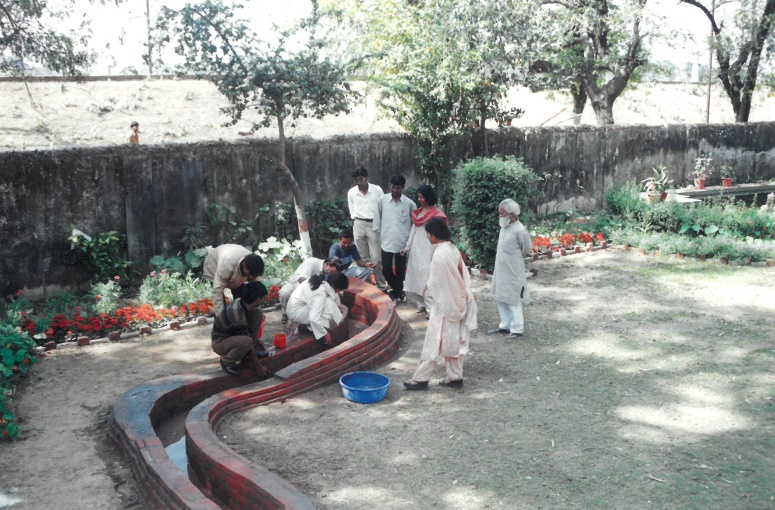
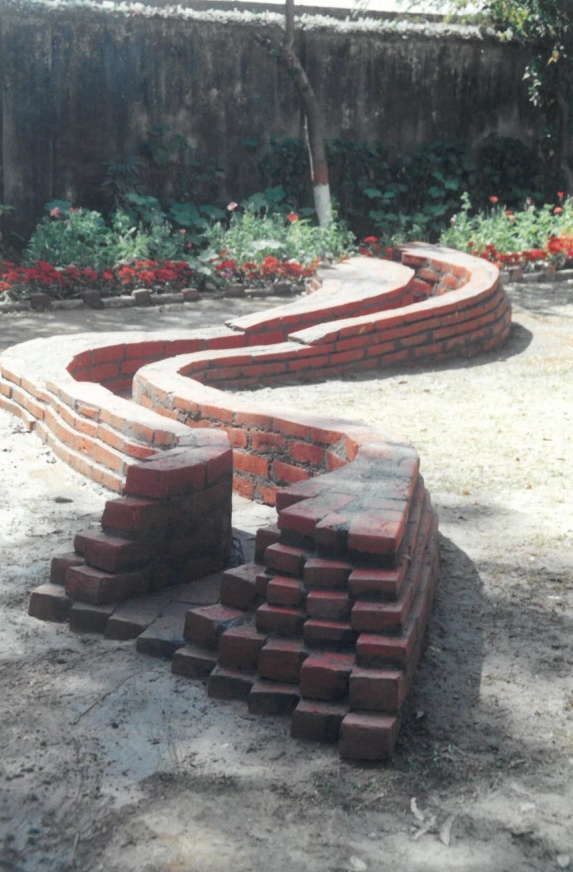
- Critical Appraisal of the 2003 Lucknow work titled “River” – Archana
The Lucknow work titled “River” came 16 years later, although he had worked with the concept of the river in 1997. The Lucknow work has the characteristic beauty of most of Madan Lal’s works. The “River” is not so much a work of sculpture but a site-specific mini-work of architecture using bricks as bricks in their original form.
Once again, I would use one of Madan Lal’s own terms in Hindi “arthavyavastha” and the various synonyms of the term in English – economy, processes of production, distribution, trade, social structures etc., to describe the “River.”
The “River” 2003, gives artistic expression to the meandering form of the flow of a river with banks on either side with steps and varying levels of structure in the horizontal form of the work.
All major civilizations grew and flourished in the vicinity of a flowing body of water. In making the work (the “River”) the artist had to enlist the help and assistance of casual workers and tradespeople, which is a positive contribution to society in the name of art.
- Madan Lal responds
Artist’s Narration – 2005 Taipei – with a description on the importance of “Well” as a subject in his art
Soon I had a chance to participate in the ‘Third Asia Pacific Arts Forum- Disguise & Identity’ at the Taipei National University of Fine Arts, Taiwan.
I used bricks to create a circular wall with a brick floor to create a “Well” of 4 meters in diameter. The brick floor followed a design pattern of concentric circles with a few bricks carved in abstract flower forms placed upright on the floor at strategic places. The brick wall of the well and the floor were held together and sealed with mortar so as to hold water.
As a child, I remember watching a well being dug near my village. I was surprised and fascinated to see a sudden appearance of water after the well had been dug to a certain depth. Many questions came to my mind: why does the water level in the well not decrease or why doesn’t the well start overflowing with water?
Watching my shadow in the well and throwing pebbles into the still water and listening to the gentle ‘plop’ sound and an echo that soon followed and observing the ripples being created gave me tremendous joy.
In time, I also noticed that the well made of bricks and cement developed some fissures and after a few years a Peepal tree and saplings of other trees took root within the structure of the walls of the well.
Gradually there grew branches and leaves that covered the inside of the well, their ever changing forms being reflected in the water of the well. Nature took over technology and created unexpected imagery that can be seen in my work in different forms and materials and at different stages of my artistic development.

- Critical Appraisal of the Taiwan work – Archana
The Taipei “Well” of 2005 is again a site-specific work like the work “River,” more in the realm of public works, as in the case of a well built for communal use, rather than a work of sculpture. (In any case, the work in its totality is not intended to be a work of sculpture , still….). The small, almost unnoticeable forms of buds and flowers placed strategically on the floor of the well are perhaps the actual artworks, these forms of nature (replete in the artist’s works) made the Well their home – harking back to his memory of the well built in the village that he witnessed as a child.
The “Well” is impressive as a structure and is visually engaging.
- Below are two murals that were not discussed in the exchanges
Varanasi: Bricks 2018 – A mural for the exterior wall of Ram Chhatpar Shilp Nyas, Varanasi, India
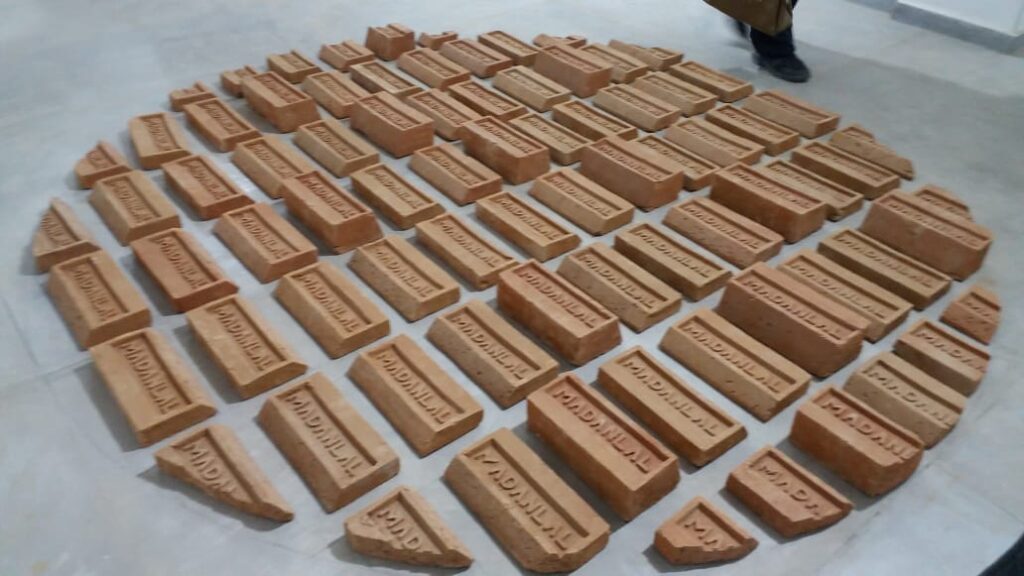
- Critical Appraisal of the 2018 Varanasi brick mural – Archana
In the Varanasi mural “Bricks 2018” above each individual brick may be seen as an artwork that mimics everyday bricks used for industrial purposes. By embossing his name in the dip within the brick (the technical term for the dip is “frog” ) the artist is making a daring attempt at appropriation of a building material that has a history of thousands of years and which has been universally used by peoples of ancient civilizations onwards until the present day.
In the mural, the placement of the bricks is in the form of a mandala, which in itself is not an original idea. However, the fact that the bricks are of different sizes and thicknesses, introduces an element of surprise – since the expectation is that bricks being a mass produced product would be of the same size – lending the composition a quiet, subtle element of artistic innovation.
Varanasi: Bricks Blossoms 2021 – a mural for the exterior wall of Ram Chhatpar Shilp Nyas, Varanasi, India
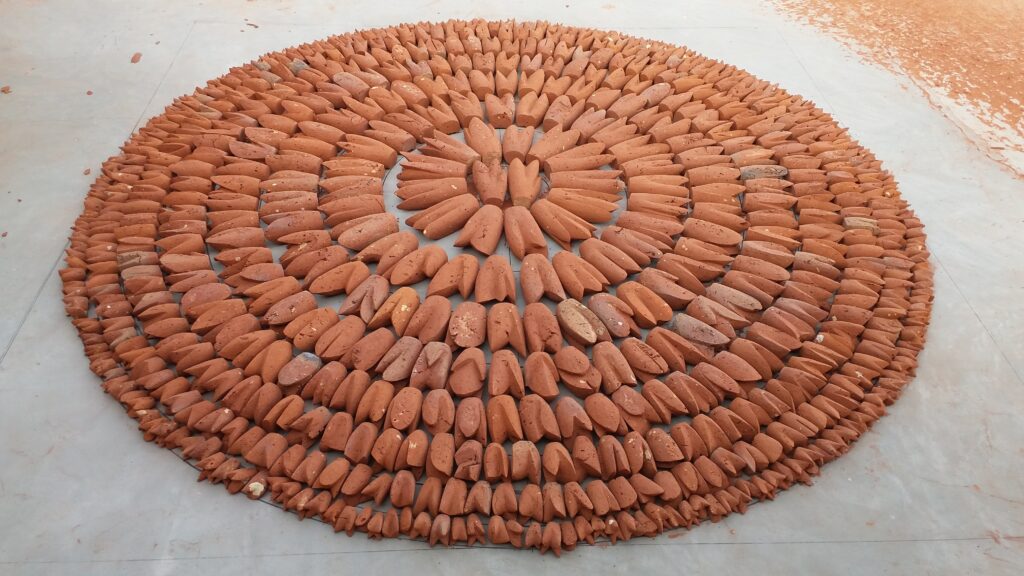
- Critical appraisal of the Varanasi mural Brick Blossoms 2021 – Archana
The above work of 2021, titled “Brick Blossoms,” a mural is composed of individually carved bricks, the carved forms are unique to each brick – no repetition. The arrangement is again reminiscent of a mandala, with an ever so slight asymmetry that can be described using just one word “beautiful.”
In the mural, the sculpted bricks gradually diminish in size as they extend outwards in larger circles from their central point. The center of the brick composition contains just two bricks as if there is an inherent duality within what is seen from afar as a unified whole in its never ending circularity.
The Dvaita, is the Advaita, but in fact it is Ramanuja’s Vishishtadvaita that we can see in the mural. (This is a philosophical construct of the Vedanta school of thought in Hinduism.)
The attention to detail, the complex calculations required to show the gradual decrease in the sizes of the bricks as they spread outwards in the composition are aspects of the mural that a viewer may not immediately grasp at first sight.
The Varanasi mural “Brick Blossoms” is best described in the artist’s own words. I would use some of the other terms from his statement on bricks in Hindi quoted above where, in addition to “vishamta”and “khurdurapan“ he uses the terms: “saadgi,” “tapasya,” “vinamrata,” “antarangata,” “prakrutik vastuon aur prakriyaon ki sundarata,” – i.e. simplicity, dedication, humility, intimacy, encompassing the beauty of natural objects and processes, respectively.”
- Feedback from Madan Lal Gupta on the Project – extracts
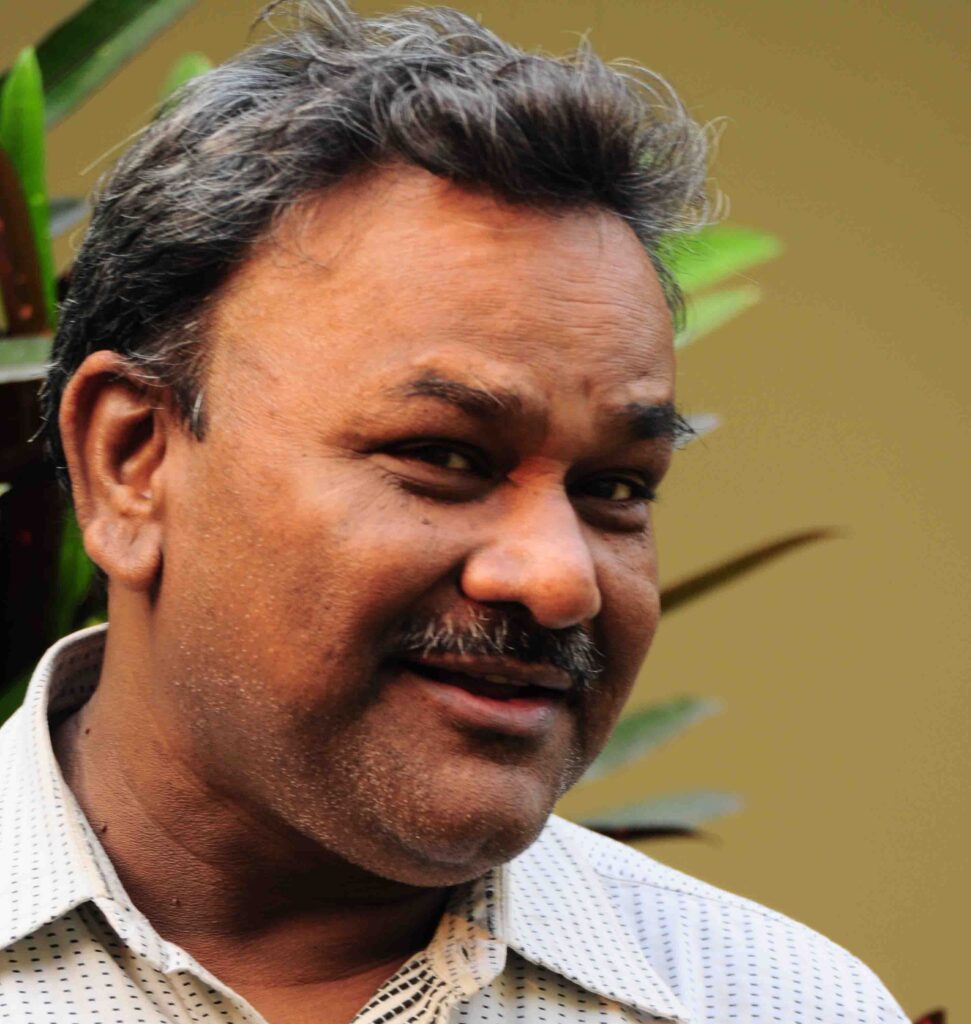
* “I am learning and seeing many things in my art and life through your perception of my work…which is deep and insightful”
*“..through these exchanges I am able to look at my life and my philosophy of art from various angles and I have come to realize that life and art are one and the same….”
*“….I have come to understand the value of proper documentation of art and the necessity to create a visual chronology of my work for future reference so the many interrelationships in my art become evident…..I realized this when you brought this aspect of art practice to my notice.. in our exchanges”
* “….these interactions guide me forward in my art and craft creations..”
Archana Hebbar Colquhoun



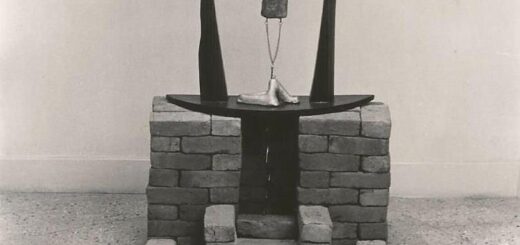
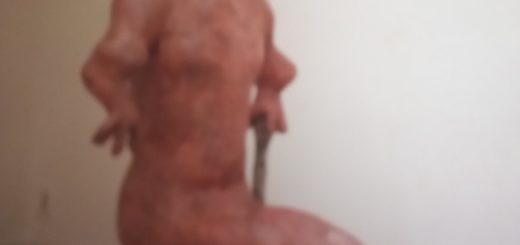
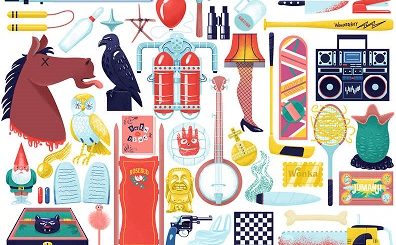

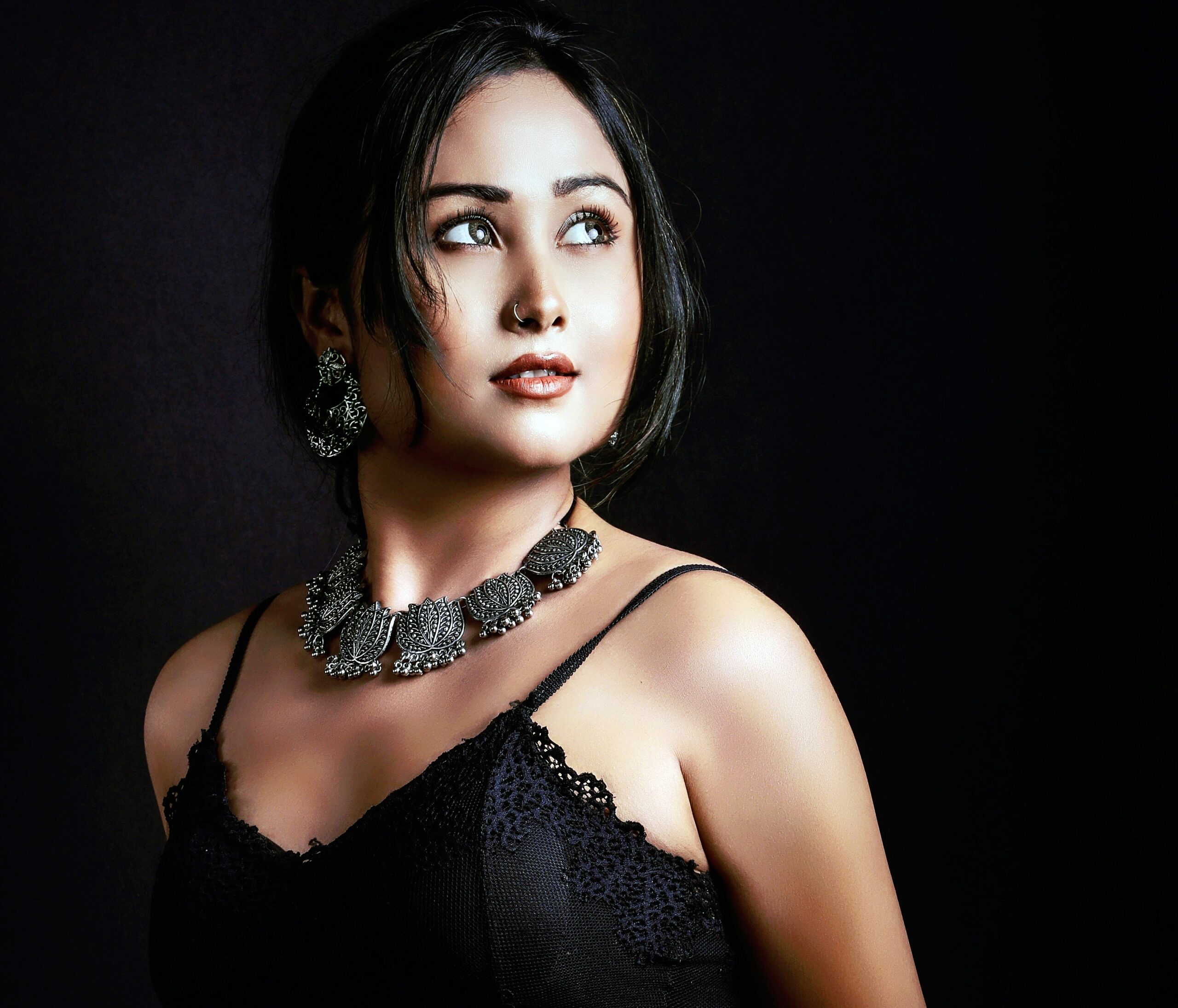


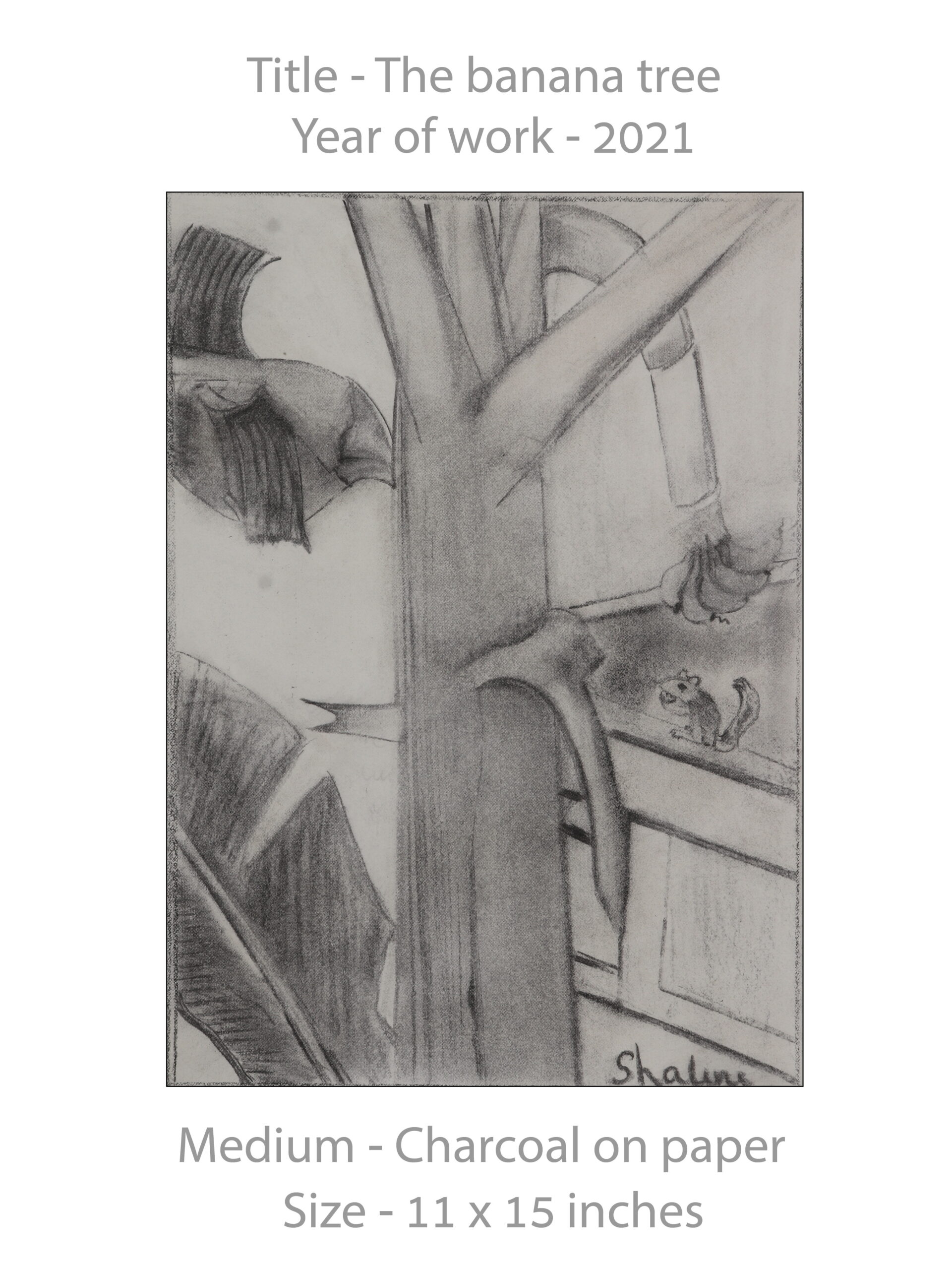
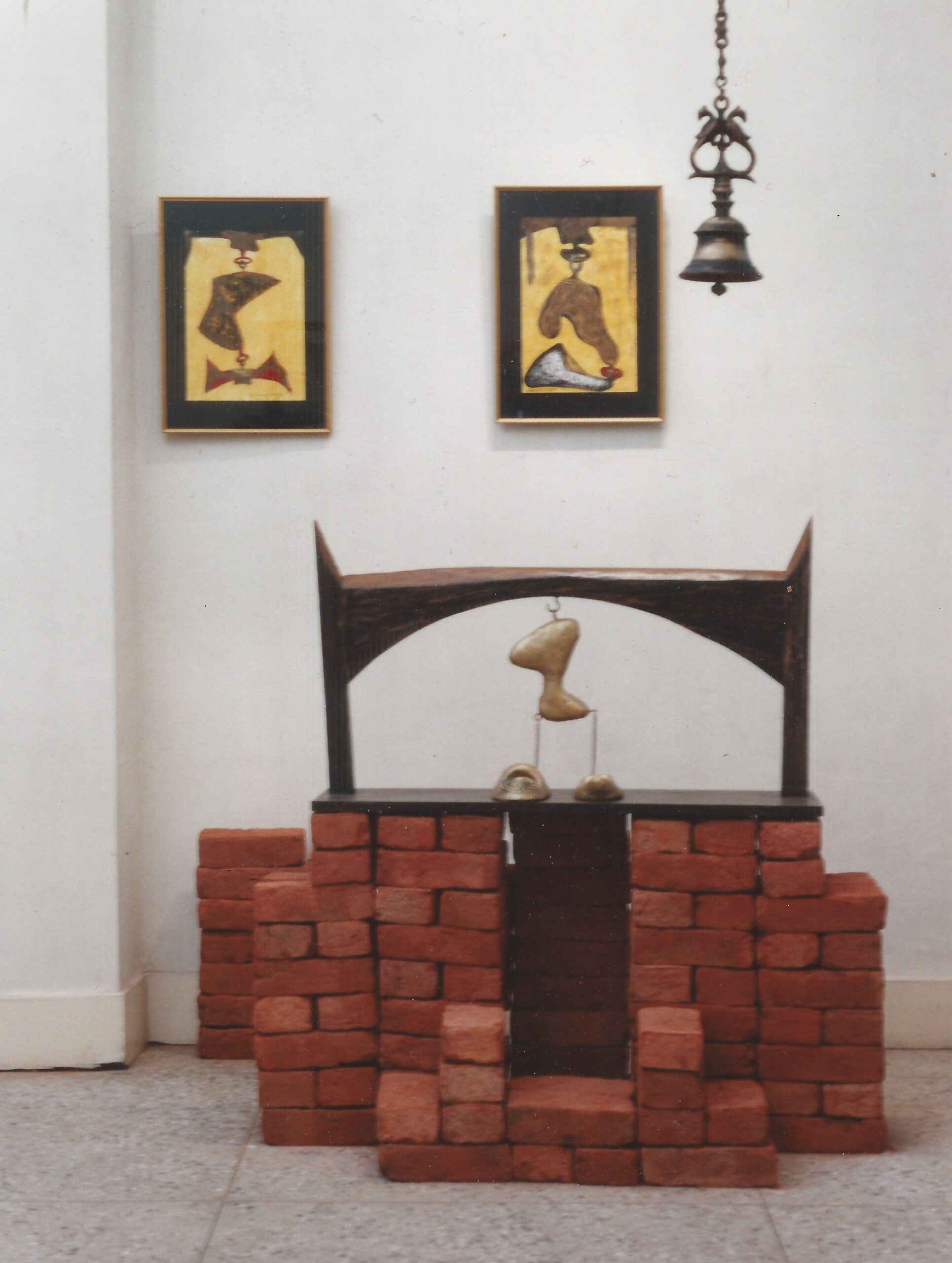
I like the way you’ve shared the content. Keep it up with good work
This is a really great summary, thanks for sharing. I like the way the bricks lying at the side of the road became the material to construct a career, and the signing of the bricks on one project is interesting too. It is a tradition that goes back to the Mesopotamian elite linking themselves to temples, gods and previous kings. Interesting work and great summary.
Thanks John for your comment. I like how you picked out 3 points from a several page write-up and connected them in a way that you cast the net wide and captured a statement that I hadn’t specifically made.
Your insight is really valuable.
Thank you so much! Your project inspires me to send you some of my new works soon … See what has been so far here:
http://www.monikathoms-artworks.com
I need to go into the landscape and into nature and compare the states of impressions and impulses of creativity with materials found outside. No harm of the surrounding is my aim and I want to spend time in all seasons out. Regeneration of life is my interest. Becoming better from a long time of experienced pain, I recognize my sensitivity as the source of both: my deep ability to feel and to express in a very big range. Pain is one side of this experience joy is the other. In both I have made many experiences I need to express.
I met Madan Lal in Varanasi in October 2008 and January 2009 , taking part in his art event on the sandbank of the Ganges.
Dear Monika,
Thank you for posting your comment. As an author of this project and with Madan Lal as an enthusiastic subject of this rather unorthodox and in-depth study of his as well as my own work, I can say with conviction that each person’s input into this project has a transformative effect that touches both Madan Lal as well as myself.
I and Madan Lal have known each other since our Baroda days and then through an unexpected course of synchronicity I met both Rajiv Lochan and Madan Lal in Japan in the late 1980s when I moved to Japan.
Wah, such a very beautifully described about my Brick sculptures chronologically. I am very happy to see finally on the Facebook stagebuzz.in
Thanks to you all.
Thanks Madan Lal. This is a project that keeps growing and changing form.
Working on the project intensively requires time to digest the contents.
Further comments from you would be welcome.